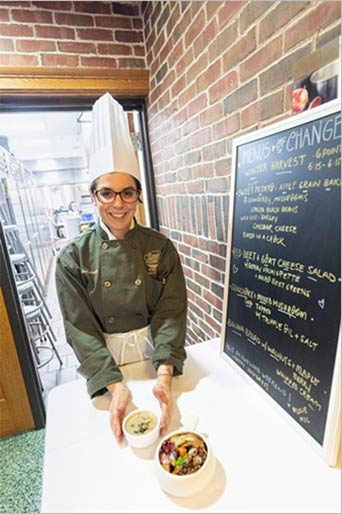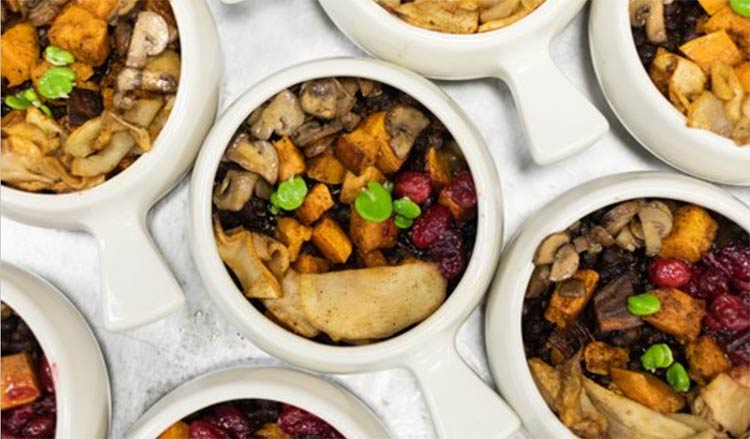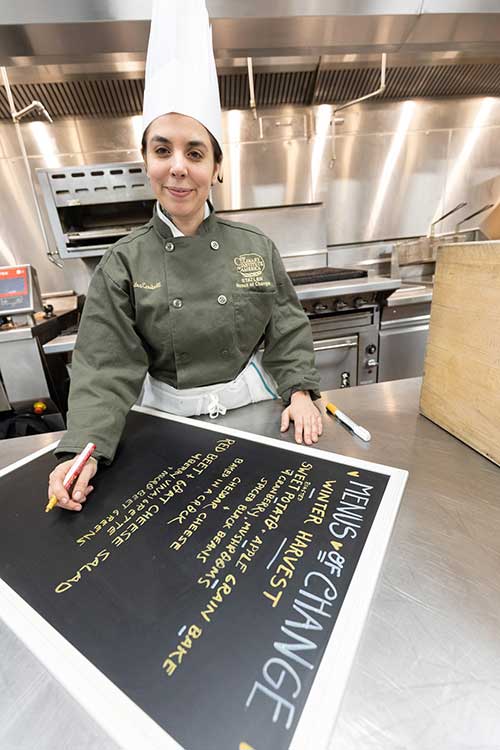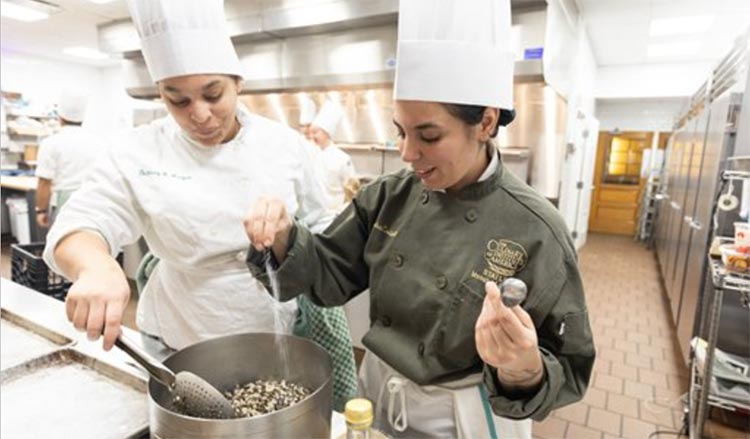If you are lucky enough to spend time on our Hyde Park, New York campus, you might see the occasional green chef’s coat winding its way through campus. That could just be me, on my way to work as chef-instructor in The Menus of Change Kitchen, where our motto is, “It’s easy being green!”
New to campus in 2019, The Menus of Change Kitchen was designed to reflect the principles of plant-forward cooking and eating—inspired by the CIA’s partnership with the Harvard T.H. Chan School of Public Health and the Menus of Change initiative. With the goals of preparing nutrient-rich food from sustainable and mostly plant-based ingredients, we opened to students in Roth Hall at the heart of a bustling campus filled with hungry students.
With my background in sustainable food systems and food advocacy, I thought we could take it another step by addressing a significant problem in the world of hospitality: food waste. What if, instead of just feeding our students delicious, healthy foods, we also committed to preparing that food with unused ingredients from around campus?
To my delight, I received enthusiastic support from fellow faculty and most of all from the students. Because we would be utilizing ingredients leftover from other classrooms and kitchens, we wouldn’t always know what would be working with. And that meant, unlike other classrooms and kitchens on campus, we couldn’t rotate through set menus. Each day was something new, which can be daunting for the average culinary student—but not mine! They may have been nervous, but my team is so inspired by the end-goal of nourishing their classmates that they jump in feet first. And sometimes head-first, if it means rooting through anther classroom’s compost bin for usable ingredients!
From brand new chefs-in-training to confident upperclassmen, the students of the Menus of Change kitchen are part of the menu development process. They are full of creative solutions to utilize whole ingredients, leaving no carrot skin or single leftover fish behind. They embrace each challenge, all at the same time learning new skills that they’ll carry through their whole careers.
The best part of menu development with the students? They are sharing recipes and techniques from their own cultures, families, and experiences, which means we are cooking wholesome, comforting dishes for even the most homesick college kids. We’re making stews straight from Grandma’s recipe box or experimenting with dishes cobbled together from old memories. Not only does this produce delicious food, but it also instills confidence in the skills our students bring with them to the CIA, and they learn to trust their instincts and their stories. 
While the Menus of Change kitchen is plant-forward, meaning not fully vegetarian or vegan, we do serve lots of vegan food. And not to brag, but despite serving predominantly vegan food, we are the most popular kitchen on campus, competing with some heavy hitters, like The Cuisines of Asia and barbecue day in the Americas kitchen. Folks who were skeptical of vegan food realized that our food is delicious first, and it sometimes also just happens to be vegan.
This popularity extends to our kitchen staff, who don’t seem to want to leave when their time with us ends. And I don’t blame them! I believe in a significant focus on “the human aspect” of sustainable kitchens, and my students are respected, never micro-managed, and have the flexibility to focus on their schoolwork, which is always the top priority. If you treat people well, they will go the extra mile—and you will have good retention and low turnover. Our kitchen is also an extension of their classrooms, and our ever-changing menu allows students to practice competencies that they’ll need for their externships and classes. The beauty of this program is that not only are we training the next generation of talented chefs, but they are deepening their respect for the food we rely on. They are the future of food, and they will implement these principles to facilitate a healthier and more vibrant planet.
Of course, perfection is not the goal in our kitchen (though I must admit, my students achieve near-perfection pretty darn often). Experimentation is at the heart of our program, and the results speak for themselves. In fact, we’ll be opening a second location in Hyde Park, which means if you come to visit The Egg, our awesome student center, you can find us serving—well, I don’t know what we’ll be making that day yet. You’ll just have to find out!
 Chef Alexandra Ceribelli ’19 is a graduate of CIA’s bachelor’s program in Applied Food Studies and lecturer at our New York campus. Chef Ceribelli also manages the Menus of Change Kitchen, where she works with students to help them better understand sustainable kitchen practices and eliminate food waste on the campus. Currently, she is teaching Introduction to Food Systems. Throughout her 17 years as a chef, she has worked in the Arctic with National Oceanic and Atmospheric Administration research scientists, developed sustainable and community-based programs in a Philadelphia homeless shelter for women and children, and worked to create food programs in inner-city public schools.
Chef Alexandra Ceribelli ’19 is a graduate of CIA’s bachelor’s program in Applied Food Studies and lecturer at our New York campus. Chef Ceribelli also manages the Menus of Change Kitchen, where she works with students to help them better understand sustainable kitchen practices and eliminate food waste on the campus. Currently, she is teaching Introduction to Food Systems. Throughout her 17 years as a chef, she has worked in the Arctic with National Oceanic and Atmospheric Administration research scientists, developed sustainable and community-based programs in a Philadelphia homeless shelter for women and children, and worked to create food programs in inner-city public schools.


